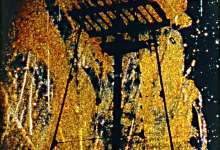Pan of the Landscape reflects Brakhage's influence, especially at its opening. But soon differences begin to appear. The black shadow of something that looks a bit like a machine part slowly traverses the visual field, asserting the presence of the mechanisms of cinema (and of the optical printer, the 'special effects' rephotography device Becks used to make his film). Rapidly-moving colours are anchored by the silhouettes of buildings in the same way the painted patterns are stilled by the shadow, and the use in Brakhage's and others' films of painting on film as means of achieving a lyrical, visionary freedom of light and color is deeply undercut, as the solid stuff of the world begins to resemble a bit of a prison. Because of these physical realities acknowledged within the film, neither the artist nor his creation seem free, and the film alternates between bursts of sensuousness and a more resigned, withdrawn, melancholy self-awareness.
«The Anti-Heroic in Recent American Avant-Garde Film» by Fred Camper
25 FPS catalogue essay (Zagreb, 2005)
Christopher Becks' Pan of the Landscape uses gorgeous Brakhage-like painting on film to un-Brakhage-like ends: spectacular skies combine with the slow, mechanical movement of a silhouetted form to produce a biting melancholy, as if Becks is mourning the film's removal from the world it glimpses.
Fred Camper, Chicago Reader (06/2005)
3 PRINTS IN DISTRIBUTION
|
distribution format |
16mm |
|
screen |
1,37 (single screen) |
|
speed |
24 fps |
|
sound |
silent |
|
rental fee |
49,00 € |
|
distribution format |
16mm |
|
screen |
1,37 (single screen) |
|
speed |
24 fps |
|
sound |
silent |
|
rental fee |
49,00 € |
|
distribution format |
16mm |
|
screen |
1,37 (single screen) |
|
speed |
24 fps |
|
sound |
silent |
|
rental fee |
49,00 € |






